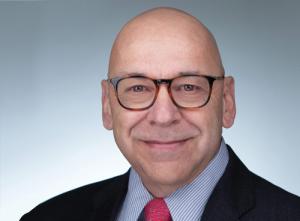NuScale
Clayton Scott is Executive Vice President for Business Development at NuScale.
Baseload power is the perfect partner to manage intermittency issues from increased use of renewables on the journey to a decarbonized electric grid. NuScale wants to be the first mover along the way with its carbon-free solution of small modular reactor technology.

The company is on a mission to bring SMR to the global energy market. It made history in 2020 as the first SMR to receive design approval from the U.S. Nuclear Regulatory Commission and would make history again by bringing the first SMR plant online by 2030.
Significant milestones are being achieved as NuScale moves forward in the U.S. and abroad, which made it the perfect time for a discussion with NuScale's EVP for Business Development, Clayton Scott. The latest advancements that portend the future of nuclear power are found here.
PUF's Steve Mitnick: Talk about what's exciting that NuScale is doing, getting to the point of putting steel on the ground in North America.
Clayton Scott: Our first project is the Carbon Free Power Project with the Utah Associated Municipal Power Systems, a consortium of utilities primarily in Utah. For the project, we have the site at Idaho National Labs, and we've done fifty or so bore drillings to set up the environmental studies.
We put the meteorological tower up and we're going through the process of getting the environmental studies done. In parallel, we've put in the order for the long lead materials for the forgings with Doosan, and we've got other announcements that will come out shortly.
We're not at a point yet where we're moving bulldozers and dirt around, but we're going through the process of prepping the land and moving the project forward.
PUF: NuScale moved to the front of the line, with review and regulation by the Nuclear Regulatory Commission. Talk about that process and your distinctive small modular reactor design.
Clayton Scott: We've achieved some significant milestones. Clearly, obtaining the U.S. NRC certificate and approval, an SER, a safety evaluation report on the technology, is a key fundamental step.
We had a record-breaking forty-two months to achieve that. Part of the reason why, is because the premise of the design has been based off sixty or seventy years of PWR experience, light-water experience.
We've taken that same aspect and made it simpler, safer, down to the technology we have today where each module produces seventy-seven megawatts of power, and we've not reinvented metals or technologies. We use the same traditional fuel that's being used in a good chunk of reactors globally today.
Having the certification was a significant effort. We put in a five-hundred-million-dollar effort to do all the support work to get the certification from the NRC. As I said, it took forty-two months.
In addition, what sets us a bit further ahead as well is our Emergency Planning Zone, EPZ. The EPZ required a seven-year process to get the final ruling, obtained last year.
Our methodology to calculate the EPZ was approved by the NRC. We're the only nuclear technology to have this ruling, and for most potential sites in the U.S., it allows us to keep it at the sites' boundaries.
Our EPZ for our site is approximately sixty acres. Whereas a traditional plant is a ten-mile radius. It's a significant difference. Having that achievement, the certification, and being the first and only one in the United States puts us out front from a regulatory and a licensee comfort position.
PUF: Talk about the qualities that make this technology so promising.
Clayton Scott: We have a lot of firsts. We're the first design that doesn't need to be connected to a grid as part of our safety case. That's key.
We can use one of the modules as a cold start or a black start island operation. Enduring as mission critical, for example, if there's a significant event, such as a hurricane, we can maintain about a hundred fifty megawatts of power.
We can ensure ninety-nine percent reliability to support mission critical facilities, such as hospitals, in the event of a catastrophe. That's something we can provide for the community.
The plant does not necessarily need to be connected to the grid for the plant's safety systems to operate. It's a convection operated reactor. There are no pumps.
We've removed a lot of the complicated safety systems you would typically find in a normal large-scale plant. They've been removed because of the simplicity of the design, which has allowed us to enhance the level of safety.
We're the only reactor technology to be licensed for twelve modules, nine hundred twenty-four megawatts. We can operate the plant with three operators.
Not only that, but there are usually station technical advisors (STA) required in a normal facility, in addition to the operators. We're the only technology that does not require STAs. It truly is a walkaway design.
Those are significant benefits that design features allow us to access. A lot of it is where we're placed, the water in the pool, and how our power modules are submersed below ground. Many aspects of the design provide safety benefits.
PUF: What's the timeline for milestones, producing power in the Idaho, Utah areas, and what is coming in the next few years?
Clayton Scott: The carbon-free project in Utah is driven by consumption needs. They don't need offtake until 2029. We're on schedule to meet a 2029 date with the UAMPS project.
Next, a similar timeline in 2029 would be the opportunity in Romania. That is a NuScale VOYGR-6 power plant at the Doicesti site, which is a coal plant conversion, and that's with Romania's state nuclear power corporation, S.N. Nuclearelectrica.
KGHM is a mining company in Poland, and they're looking to deploy a six-module site, as well. It'd be in the 2030, 2031 timeframe.
The most immediate one at this point is UAMPS. We are talking to some customers who have pre-approved sites, and if we were able to secure one of those, there's potential where we could accelerate to an earlier timeline, but that's yet to be seen.
PUF: Is it possible by the early 2030s that you could be scaling up and installing a few of these?
Clayton Scott: Projections for power needs in North America by 2050 are around two hundred gigawatts of additional nuclear. That's just in the United States.
Global needs are higher, because this is turning into — not just a carbon issue — an energy security issue, and we're finding that in many countries in Europe, especially eastern Europe. Combine that with continued energy needs and the SMR market is tremendous.
There's room for more than one player. We want to be the first mover. But we see opportunities, especially in the U.S. with the Inflation Reduction Act.
There's a lot of benefit to coal plant repurposing from a cost-per-megawatt-hour savings with the tax credit. Plus, you gain more tax credit benefit from hydrogen production. Take all those combined, there's a large market.
PUF: There're concerns about fuel, labor, and materials. How are you at NuScale thinking about this?
Clayton Scott: Around the fuel, we must look at the fact there're two different reactor designs. The light-water designs don't have the fuel issue you see with designs that require HALEU fuel.
For example, NuScale's SMR design runs on conventional nuclear fuel, which is available today and can be sourced by existing PWR fuel suppliers, ensuring consistency with existing supply chains and a choice of suppliers from several countries.
On the regular fuel, we need to be conscious because there's a huge market ahead of us, and we have the existing fleet that needs to keep running. Fuel is something we need to pay attention to.
The labor force is a reality. The general construction labor force is an area of need in this country, whether it's in the nuclear sector or not. That's something the whole infrastructure industrial aspect of the country needs to look at.
The good aspect is that our plants are simple. For a twelve-module plant, we need approximately two hundred seventy employees to operate the plant.
Most coal plants have a similar amount of people or maybe a few more. Most of those people can be retrained into positions within a NuScale VOYGR plant.
The operators need to go through formal operator training, but aside from that, the engineers, technicians, et cetera, they can learn the ins and outs of a NuScale plant with minimal training and typically better pay. We're not concerned about people working at the plant if we repurpose facilities.
If you look in the past, when you start seeing an industry move, people start refocusing their career paths. I'm confident the country and industry will get there. But yes, these are all realities.
PUF: Talk about the people of NuScale and how you look at your challenges and successes so far.
Clayton Scott: I'm relatively new. I've been at NuScale a little over a year, but I've been in the nuclear industry for about forty-two years, so I'm not new to the industry. I knew Dr. José Reyes, our co-founder, from when he was at the NRC before he was at NuScale.
As for the company, I have been impressed that there're a lot of young people and energy when you put them in the same room. A lot of bright minds.
It's amazing that the company started out with this new design, walked it through some hard times financially, but everybody believes in it, regardless of what's happened.
With recent achievements getting the certification, people are pumped up. They want to see this happen. They've been in the research and development mode for most of the company's operations.
It's time to change into deployment mode, into commercial movement. That's where I've come into the scene, to change the dynamic to move forward in a sales perspective and into a deployment mindset.
The company knows we are well advanced compared to others, and we see movement. I guarantee that once the bulldozers start moving on the site, people will be excited. But I don't see any lack of commitment from anybody in this company.



